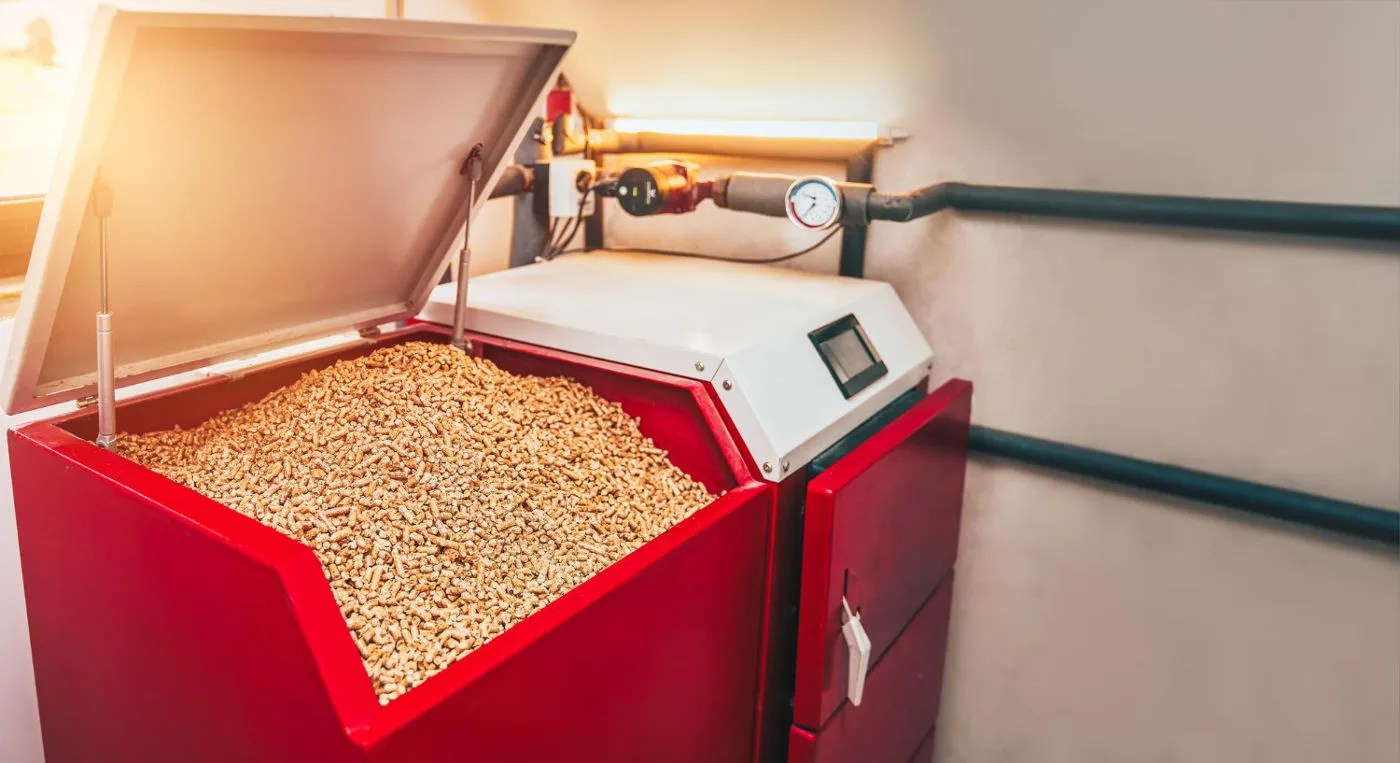How Does a Biomass Boiler Work? The Comprehensive Guide to Modern Renewable Heating
As the world transitions away from fossil fuels, the heating industry is undergoing a significant evolution. Homeowners, facility managers, and sustainability consultants are increasingly turning their attention to renewable alternatives to gas and oil. Among the most robust and proven technologies in this sector is the biomass boiler.
While the concept of burning wood for heat is as old as civilization itself, a modern biomass boiler is a marvel of automated engineering. It is far removed from the open fireplaces or rudimentary log burners of the past. Today’s systems are sophisticated, computer-controlled units capable of rivaling the convenience of gas while delivering a carbon-neutral heating solution.
But how exactly does a biomass boiler work under the hood? To understand its efficiency and value, we must dive into the mechanics of fuel delivery, combustion technology, and thermal transfer.
What is a Biomass Boiler?
At its simplest, a biomass boiler is a heating system that burns biological plant material—usually wood—to generate heat for use in a central heating system and hot water cylinders.
Unlike a standard wood stove that radiates heat directly into a single room, a biomass boiler is a hydronic system. It is connected to your property’s wet central heating system (radiators or underfloor heating), functioning as a direct replacement for a gas or oil boiler.
The defining characteristic of a modern biomass system is automation. High-end biomass boilers regulate their own fuel supply, manage airflow for optimal combustion, and even clean themselves, requiring minimal intervention from the user.
The Fuel: The Lifeblood of the System
To understand how the machine works, one must first understand the fuel. Biomass boilers are generally categorized by the type of wood fuel they consume. The three main categories are:
- Wood Pellets: These are the most common fuel for domestic and light commercial biomass boiler systems. Pellets are made from compressed sawdust and industrial wood waste. They have a uniform shape, low moisture content (usually below 10%), and a high energy density. This uniformity allows them to be treated almost like a fluid, flowing through pipes and augers with ease.
- Wood Chips: Used primarily in medium-to-large commercial installations, wood chips are shredded timber. They are cheaper than pellets but require larger storage silos and sturdier feed mechanisms due to their irregular size and higher moisture content.
- Logs: Log gasification boilers require manual loading. While less automated, they are highly efficient for those with access to their own timber supply.
For the purpose of explaining the automated mechanics, this article will focus primarily on pellet and chip biomass boilers, as these represent the pinnacle of automated heating technology.
Step-by-Step: The Mechanics of Operation
The operation of a biomass boiler can be broken down into four distinct phases: Fuel Delivery, Ignition and Combustion, Heat Exchange, and Exhaust Management.
- Fuel Storage and Delivery (The Feed System)
The process begins in the fuel store. For a biomass boiler to operate autonomously, it needs a large reserve of fuel, usually stored in a silo or a hopper adjacent to the boiler room.
When the boiler’s thermostat calls for heat, a signal is sent to the feed system.
- The Auger: Most systems utilize a flexible or rigid screw auger (an Archimedes screw). As the screw turns, it pulls pellets or chips from the bottom of the silo and transports them upward toward the boiler.
- Vacuum Systems: In residential settings where the fuel store is located some distance from the boiler, a vacuum suction system may be used to transport pellets through pipes using air pressure.
The fuel is dropped into a distinct “intermediate” hopper or dosing valve on the boiler itself. This serves a crucial safety function: it creates a physical break (a “burn-back” protection) between the combustion chamber and the main fuel store, ensuring fire cannot travel back up the auger into the silo.
- Ignition and Combustion
Once the fuel enters the combustion chamber (the burner pot or grate), the ignition cycle begins.
- Auto-Ignition: You do not need matches. An electric heating element or hot air blower directs intense heat onto the fresh fuel. Within minutes, the pellets ignite.
- Controlled Airflow: This is where professional engineering sets a biomass boiler apart from a bonfire. The boiler’s internal computer (ECU) controls variable speed fans that introduce air into the chamber.
- Primary Air is introduced from beneath the fuel to stimulate the fire.
- Secondary (and Tertiary) Air is introduced above the flame. This ensures that gases released by the burning wood are also combusted (gasification), squeezing every joule of energy out of the fuel and significantly reducing smoke and emissions.
The boiler modulates the fuel feed rate and fan speed to match the heating demand. If the house needs only a little heat, the boiler slows the auger and fans down; if demand is high, it ramps them up.
- The Heat Exchanger
The fire inside the combustion chamber creates hot flue gases, often reaching temperatures exceeding 800°C to 1,000°C. However, the goal is not to heat the boiler, but to heat the water.
The hot gases are drawn through a multi-pass heat exchanger. This is a series of metal tubes or channels surrounded by the boiler’s water jacket. As the hot gas travels through these tubes, the thermal energy transfers through the metal and into the water.
By the time the gases reach the exit of the heat exchanger, their temperature has dropped significantly (often to around 100°C – 150°C), meaning the majority of the energy has been successfully captured by the water. This heated water is then circulated to your radiators, underfloor heating manifold, or hot water cylinder.
- Ash Management and Exhaust
Burning wood inevitably produces ash, though less than one might expect. High-quality wood pellets produce less than 1% ash by volume.
- Self-Cleaning Mechanisms: Premium biomass boiler models feature automatic cleaning systems. Mechanical levers or springs inside the heat exchanger tubes move periodically to scrape off soot deposits, ensuring maximum heat transfer efficiency is maintained.
- Ash Compression: The ash from the combustion grate usually falls into an ash pan. Advanced systems use an auger to compress this ash into a removable box, meaning the user only needs to empty the ash bin a few times per heating season.
Finally, the remaining flue gases are expelled through a flue system (chimney). Modern installations often include particulate filters or cyclone separators to minimize particulate matter emissions, ensuring clean air compliance.
The Role of the Buffer Tank (Thermal Store)
From a professional heating design perspective, explaining how a biomass boiler works is impossible without mentioning the buffer tank (also known as a thermal store or accumulator).
Unlike gas boilers, which can turn on and off instantly (cycling) without much issue, biomass boilers are most efficient when they run for long, continuous periods. Frequent ignition and shutdown cycles reduce efficiency and increase wear on components.
To solve this, a large insulated water cylinder—the buffer tank—is installed. The biomass boiler heats the water in this tank, essentially turning it into a large thermal battery. When your home thermostat calls for heat, the hot water is drawn from the buffer tank, not directly from the boiler.
This arrangement allows the boiler to fire up, run at maximum efficiency until the tank is fully charged, and then turn off for hours or even days, while the house draws heat from the stored water. This maximizes the lifespan of the unit and ensures consistent comfort.
Environmental Impact and Carbon Neutrality
A common question regarding how a biomass boiler works is: “Does it create pollution?”
While burning wood releases Carbon Dioxide (CO2), biomass is classified as a low-carbon or carbon-neutral energy source. The scientific rationale is the Carbon Cycle. The tree that produced the wood fuel absorbed CO2 from the atmosphere while it was growing. When that wood is burned, it releases that same CO2 back into the atmosphere. This is a closed loop.
In contrast, burning gas or oil releases “fossil carbon” that has been locked underground for millions of years, adding new CO2 to the atmosphere and accelerating climate change.
Furthermore, modern biomass boilers are strictly regulated regarding particulate emissions. When properly maintained and used with high-quality fuel, their smoke emission is negligible compared to open fires or older stoves.
Pros and Cons of Biomass Systems
For professionals and homeowners considering this technology, an honest assessment of the advantages and disadvantages is vital.
The Advantages
- Sustainability: A significant reduction in the property’s carbon footprint.
- Fuel Cost Stability: While pellet prices fluctuate, they are generally less volatile than geopolitical oil and gas markets.
- Efficiency: Modern units operate at 90%+ efficiency.
- Utilization of Waste: It utilizes forestry by-products and waste wood that might otherwise go to landfill.
The Challenges
- Space Requirements: A biomass boiler is larger than a gas combi, and the fuel store requires significant square footage.
- Initial Investment: The capital cost of installation is higher than fossil fuel equivalents (though running costs can be lower).
- Maintenance: While automated, they require more interaction than gas. Ash bins must be emptied, and annual professional servicing is critical.
Installation and Maintenance Considerations
Installing a biomass boiler is not a DIY job; it requires a qualified heating engineer (in the UK, for example, an MCS-certified installer). The installation involves complex hydraulic integration with the buffer tank, flue draft calculations to ensure safety, and compliance with local building codes regarding ventilation.
Maintenance is the key to longevity. A well-maintained biomass system can last 20 to 25 years.
- Weekly/Monthly: User checks ash levels and tops up fuel.
- Yearly: A professional biomass boiler service engineer cleans the heat exchangers, checks the Lambda sensor, greases bearings on the auger, and inspects the fire bricks in the combustion chamber.
Is a Biomass Boiler Right for Your Project?
Understanding how a biomass boiler works reveals that it is a solution best suited for specific types of properties. It is ideal for:
- Properties “off the gas grid” currently relying on expensive oil or LPG.
- Larger homes or commercial buildings with high heat demand.
- Properties with sufficient space for a plant room and fuel delivery access.
Conclusion
The modern biomass boiler is a triumph of engineering, bridging the gap between our oldest fuel source and our future need for sustainable living. It works by automating the combustion of wood to a level of precision that extracts maximum energy with minimal waste.
By combining intelligent feeding systems, lambda-controlled combustion, and thermal storage, these boilers offer a viable, powerful, and green alternative to fossil fuels. For those willing to invest in the infrastructure and embrace a heating system that connects them closer to their energy source, biomass represents a smart, future-proof choice.
As we move toward a net-zero future, understanding technologies like the biomass boiler is essential for making informed decisions about how we heat our buildings and protect our environment.
To learn more about biomass boiler please visit our website https://proadvance.co.uk





